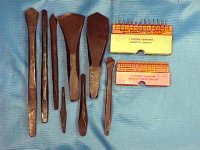ClearanceFit
Plastic
- Joined
- Apr 10, 2013
- Location
- St. Louis, MO
The topic says it all. This question infests my mind when I'm at work.
How would one fixture a part before the days of vises, magnets, and chucks?
I understand that t-slots and face plates are OLD, but when did some of this technology come about? And how did they make due before hand?
Things like lathe dogs, turning between centers, the concept of the surface grinder, etc.
How did they make precision grinding work before better materials like aluminum oxide and wheels with a vitrified bond?
When did twist drills replace the spoon drills?
Who invented the cross slide rotary table? How did they make due before hand?
How did the old school tool makers fit complex shapes after heat treat when carbide, EDM, and hard milling didn't exist?
Feel free to throw in your ideas and speculations. If you have similar questions, throw them in. Lets see where this thread goes.
How would one fixture a part before the days of vises, magnets, and chucks?
I understand that t-slots and face plates are OLD, but when did some of this technology come about? And how did they make due before hand?
Things like lathe dogs, turning between centers, the concept of the surface grinder, etc.
How did they make precision grinding work before better materials like aluminum oxide and wheels with a vitrified bond?
When did twist drills replace the spoon drills?
Who invented the cross slide rotary table? How did they make due before hand?
How did the old school tool makers fit complex shapes after heat treat when carbide, EDM, and hard milling didn't exist?
Feel free to throw in your ideas and speculations. If you have similar questions, throw them in. Lets see where this thread goes.






